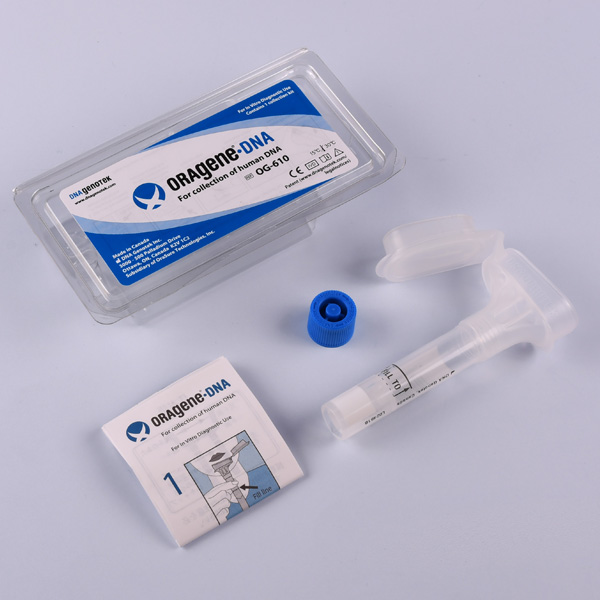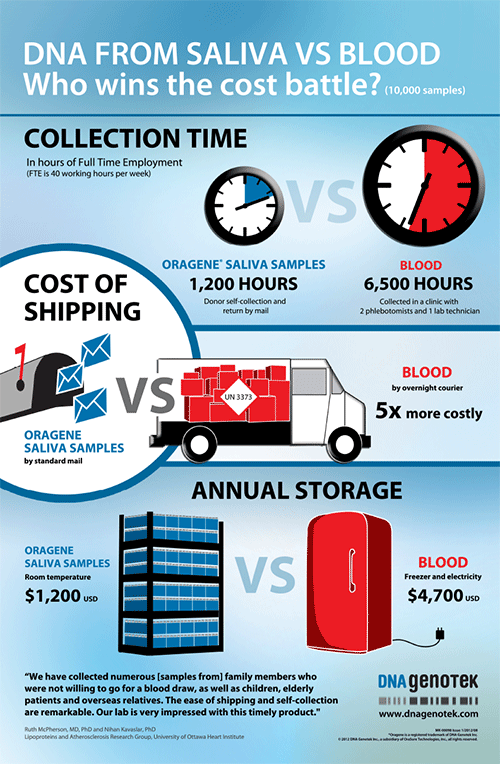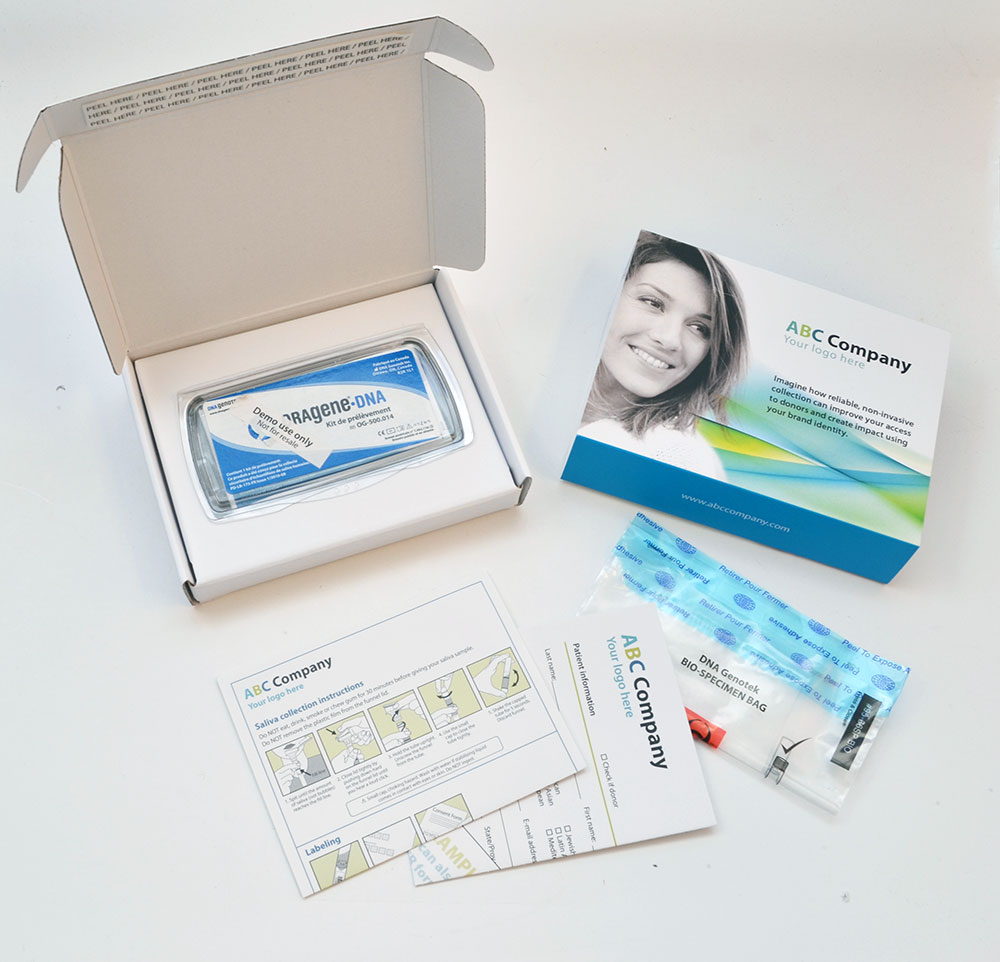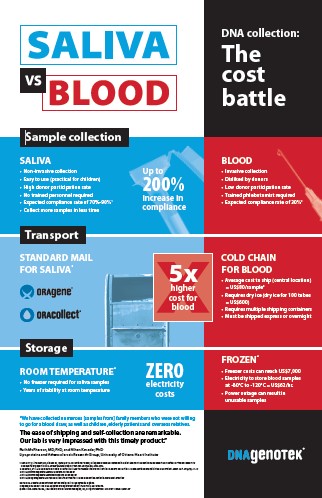- Fast and painless self-collection
- Equivalent to blood for DNA analysis
- DNA is stable for years at ambient temperature
- Optimized for both manual sample processing and automated workflows
- Integrated 1D barcode + optional 2D bottom barcode for workflow efficiency
- Proven on targeted and whole genome sequencing
 |
OG-610
|
OG-610
The Oragene™•DNA device has now been replaced with the Oragene™•Dx device. To explore the devices available in your region, visit www.dnagenotek.com or email info@dnagenotek.com to get in touch with an account manager.

Collect superior samples for your genetic analysis and testing
All genetic analysis starts with the collection of DNA samples. Collect reliable samples with an all-in-one system for the collection, stabilization and transportation of DNA from saliva.
Overview
Product Benefits
View donor user instructions
Collection method comparison chart
Blood Collection |
Oral Collection |
|||
Attributes |
Venous blood |
Mouthwash |
Buccal swabs |
Oragene•DNA (OG-610) |
|---|---|---|---|---|
Non-invasive collection |
✘ |
✘ |
✔ |
✔ |
Standardized format for high-throughput processing |
✔ |
✘ |
✘ |
✔ |
Specimen stability at room temperature |
Days |
Weeks |
Days |
Years |
Low bacterial content |
✔ |
✘† (up to 60% bacterial content) |
✘† (up to 90% bacterial content) |
✔† (median 11.8% bacterial content) |
Median DNA yield |
30 µg |
35 µg |
2 µg |
55 µg |
Sample size |
1 mL |
10 mL‡ |
1 swab |
1 mL |
Molecular weight |
> 23 kb |
> 23 kb |
> 23 kb |
> 23 kb |
Shipping at ambient temperature |
✘ |
✔ |
✔ |
✔ |
Full customization available |
✘ |
✘ |
✘ |
✔ |
† Birnboim, H.C., Iwasiow, R.M. and James, C.M.P. (2008). Human genomic DNA content of saliva samples collected with the Oragene self-collection kit. DNA Genotek. PD-WP-011.
‡ Volume of mouthwash used for sample collection.
For In Vitro Diagnostic Use.
Oragene•DNA is not available for sale in the United States. Some DNA Genotek products may not be available in all geographic regions.
Full terms and conditions for all DNA Genotek products are available here.
DNA Genotek's sample collection devices and nucleic acid stabilization chemistries are protected by issued and pending patents in numerous countries around the world.
Literature
Data Sheets
Collect & Transport
Collect & Transport
Oragene collection instructions
Instructions for self or assisted collection in multiple languages.
Mailing accessories and shipping recommendations
DNA Genotek has created a mailing solution that complies with International Air Transport Association (IATA) regulations for samples not expected to be pathogenic, while also protecting the collection kit on the way to and from the donor.
Customization options
Storage & Stability
Videos
Processing of DNA Genotek saliva tubes on SARSTEDT Lab Automation (copyright SARSTEDT AG & Co. KG).
Why I use Oragene. Watch this video and learn why so many customers choose Oragene.
What discoveries will you make using Oragene?
What would you tell a peer about Oragene?
Impact of sample type (blood vs saliva) and analytical methods on NGS data quality.
Yield & Quality
Yield & Quality
PD-PR-01042: How to maximize DNA yield with Oragene self-collection kit
7 tips to maximize DNA yield. Tips 4 - 7 specifically note purification and quantification.
PD-WP-00031: Impact of population and laboratory methods on DNA yield and variability
Summary of the total DNA yield from Oragene/saliva samples as reported in peer-reviewed publications.
PD-WP-011: Human genomic vs bacterial DNA content of Oragene/saliva samples
Quantitative information about the amount of human genomic and bacterial DNA in Oragene/saliva samples, as estimated by two different methods.
MK-AN-017: Tips to improve the A260/A280 ratio of Oragene-purified DNA samples
Despite the fact that sample turbidity (i.e., absorbance at A320) does not affect down-stream analysis, some users have enquired about modifications to our standard protocol that will improve this ratio. In this document, we describe 3 alternative methods that can be used to obtain high A260/A280 ratios from all samples.
Lab Protocols
Lab Protocols
Protocols
Manual Purification
Compatibility with Automated Purification
Quantification
PD-PR-075: DNA quantification of Oragene/saliva samples
Protocol to quantify purified total dsDNA by fluorescence (specific for double-stranded (ds) DNA). Measurement of absorbance at 260 nm (A260) is commonly used for quantifying DNA. Disadvantages of using A260 include (i) insensitivity of the assay, and (ii) interference by non-DNA components such as RNA.
MK-AN-017: From turbidity to clarity: Simple methods to improve the A260/A280 ratio of Oragene-purified DNA samples
Despite the fact that sample turbidity (i.e., absorbance at A320) does not affect down-stream analysis, some users have enquired about modifications to our standard protocol that will improve this ratio. In this document, we describe 3 alternative methods that can be used to obtain high A260/A280 ratios from all samples.
PD-PR-040: RNA removal within Oragene/saliva samples
This protocol describes the use of double-RNase digestion to remove the RNA in Oragene/saliva samples.
PD-PR-065: Bacterial DNA assay
The purpose of this assay is to determine the bacterial DNA content of purified DNA from Oragene/saliva samples.
PD-WP-00030: Dye-free quantification of Oragene/saliva DNA extracts using the Trinean DropSense96® droplet reader and cDrop™ spectral analysis software
The purpose of this application note is to evaluate the Trinean method with a cDrop protocol specific for DNA extracted from Oragene/saliva samples using prepIT•L2P.
Downstream Applications
Downstream Applications
Accessories
 Because the study is non-invasive, it is easy to participate. The DNA that you get from Oragene/saliva samples is of equal quality to DNA that you get from blood, and unlike blood, these samples will be stable at room temperature for long-term storage.
Because the study is non-invasive, it is easy to participate. The DNA that you get from Oragene/saliva samples is of equal quality to DNA that you get from blood, and unlike blood, these samples will be stable at room temperature for long-term storage.
Susan Kadlubar, PhD
University of Arkansas for Medical Sciences (UAMS)

DNA from saliva vs. blood
Who wins the cost battle?
Overcoming challenges in DNA sample collection.
Download this research report to help you increase your compliance rate.
Speed your time-to-market with a complete end-to-end sample collection solution
Our products can be fully customized to meet your time to market, streamlined end-to-end operational workflows, and branding requirements.



